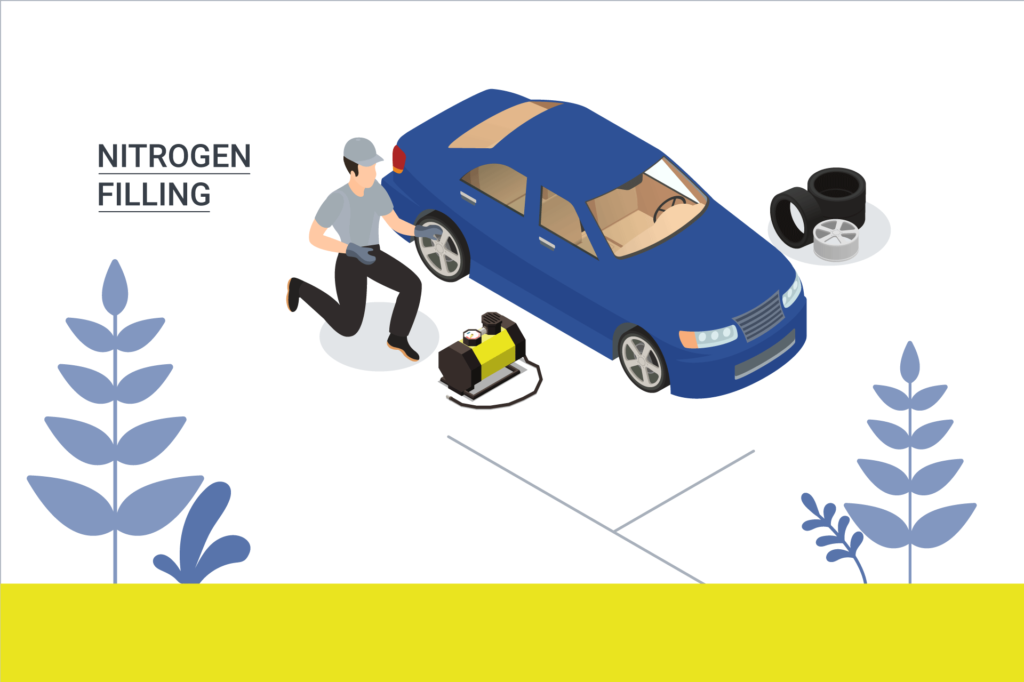
Nitrogen filling
Nitrogen filling for tires is a process where tires are inflated with nitrogen instead of the more commonly used compressed air. Here’s a detailed overview of what nitrogen filling involves, its benefits, and how it compares to traditional air filling:
What is Nitrogen Filling?
Nitrogen filling involves using nitrogen gas to inflate vehicle tires. Unlike compressed air, which is composed of approximately 78% nitrogen, 21% oxygen, and trace amounts of other gases, nitrogen filling uses 100% nitrogen or nearly pure nitrogen.
Benefits of Nitrogen Filling
Reduced Pressure Loss:
- Stability: Nitrogen molecules are larger than oxygen molecules, which makes them less likely to permeate through the tire walls. This results in more stable tire pressure over time.
- Less Frequent Adjustments: Tires filled with nitrogen maintain pressure better, which means less frequent top-ups.
Improved Fuel Efficiency:
- Consistent Pressure: Properly inflated tires contribute to better fuel efficiency. Since nitrogen helps maintain consistent tire pressure, it can help in optimizing fuel consumption.
Enhanced Tire Life:
- Reduced Oxidation: Nitrogen is less reactive than oxygen, which helps reduce the oxidation of tire rubber and internal components. This can potentially extend the life of the tires.
Better Performance:
- Stable Performance: Consistent tire pressure leads to improved handling, braking, and overall driving performance.
Less Moisture:
- Reduced Corrosion: Nitrogen is dry compared to compressed air, which can contain moisture. This reduction in moisture helps in minimizing internal corrosion and rusting of the rim and other tire components.
How is Nitrogen Filling Done?
Remove Existing Air:
- Deflate the Tire: If the tire is already inflated with air, it is necessary to remove as much of the existing air as possible. This is typically done by deflating the tire completely.
Purge the Tire:
- Remove Residual Air: The tire is purged of air to ensure that as much oxygen and moisture as possible are removed. This is usually done by inflating and deflating the tire a few times.
Fill with Nitrogen:
- Inflate the Tire: Using a nitrogen filling station, the tire is then inflated with nitrogen gas. The technician ensures the tire is filled to the recommended pressure.
Seal and Check:
- Ensure Proper Pressure: The tire is checked to ensure it is properly inflated to the manufacturer’s specifications. The valve is then sealed, and any excess nitrogen is managed.
Reinstall the Tire (if applicable):
- Replace and Secure: If the tire was removed from the vehicle, it is reinstalled, and the lug nuts are tightened to the correct specifications.
Comparisons to Air Filling
- Cost: Nitrogen filling services may be more expensive than using compressed air. However, the benefits can outweigh the cost for some users.
- Availability: Nitrogen filling stations are less common than traditional air pumps, though they are increasingly available at some service centers and dealerships.
- Effectiveness: While nitrogen offers several benefits, for most everyday driving needs, regular air filling with periodic checks and adjustments may be sufficient.
